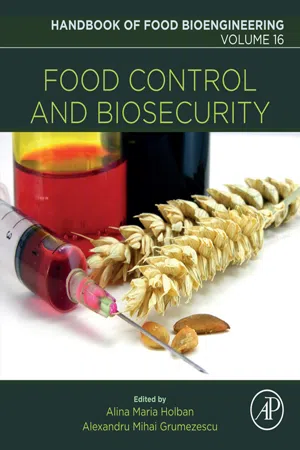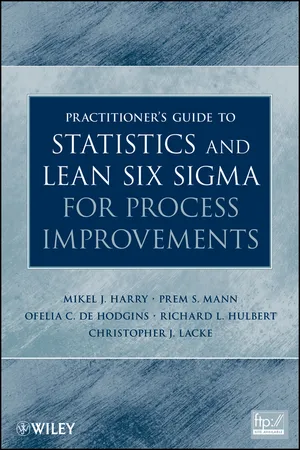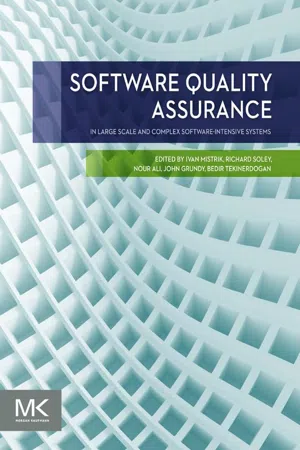Technology & Engineering
Quality Tools
Quality tools are instruments or techniques used to analyze and improve processes, products, or services. They help identify and solve problems, make data-driven decisions, and enhance overall quality. Examples of quality tools include flowcharts, histograms, Pareto charts, scatter diagrams, and control charts. These tools are commonly used in various industries to ensure high standards and continuous improvement.
Written by Perlego with AI-assistance
Related key terms
7 Key excerpts on "Quality Tools"
- eBook - ePub
- Alexandru Mihai Grumezescu, Alina Maria Holban(Authors)
- 2018(Publication Date)
- Academic Press(Publisher)
Vining et al., 2016 ).2. Seven Basic Quality Tools
Some authors stress that without the usage of suitable Quality Tools there is no successful implementation of any quality assurance systems (Bayo-Moriones and Merino-Díaz de Cerio, 2001 ; Djekic et al., 2014b ; Sousa et al., 2005 ). This also implies high rates of failures in implementing improvement tools (Cândido and Santos, 2011 ; Tarí et al., 2007 ). Because variability is often a major source of poor quality, statistical techniques, including statistical process control (SPC), are the major tools of quality control and improvement (Montgomery, 2013 ). These tools are necessary to provide adequate quality control.A Japanese scientist, Kaoru Ishikawa, determined seven basic Quality Tools that should be implemented in every company: flowcharts, check sheets, histograms, Pareto diagrams, cause and effect diagrams, scatter diagrams, and control charts (Ishikawa, 1986; Tarí and Sabater, 2004 ). The American Society for Quality refers to them as “the old,” “the first,” or “the basic seven” (Tague, 2004 ) while Montgomery calls them the “magnificent seven” (Montgomery, 2009 ). Usage of these visual tools allows factory workers to diagnose and possibly eliminate their quality problems without detailed knowledge of statistics (Smith et al., 2014 ). Simple presentation of the rationale for using these tools is presented in Table 3.1 (Đekić, 2010 - eBook - ePub
- Abdul Razzak Rumane(Author)
- 2017(Publication Date)
- CRC Press(Publisher)
(Source : Feigenbaum, A.V. (1991), Total Quality Control, Reprinted with permission of The McGraw-Hill Education.) Quality engineering becomes the field, or apex, of the triangle. The technical work area of the discipline—quality systems implementation—is shown in the first tier. The second tier then shows the principal techniques of quality engineering technology. Quality engineering relates the particular requirements of the plant and companies to the available quality technology—including both hardware equipment and planning and control actions—to put in place much of the ongoing operating detail of the quality systems framework for the firm. Quality engineering technology thus provides the technical areas to deal with such questions as the following: What are the specific details of the control activities to take place during the development and production and service cycles? Will these quality activities best be accomplished through the use of quality information equipment or by the use of people guided by procedures? What information and material inputs will be needed? What type of information data is required? How should it be analyzed, and what sort of feedback should be used? Depending upon the differences in the product-quality levels encountered, what criteria are there for alternative courses of corrective action? Feigenbaum (1991) has further elaborated the entire range of techniques used in quality engineering technology by grouping them under three major headings: Formulating of quality policy. Included here are techniques for identifying the quality objectives and quality policy of a particular company as a foundation for quality analysis and systems implementation. Product-quality analysis. Techniques for analyzing include those for isolating and identifying the principal actors that relate to the quality of the product in its served market - Mikel J. Harry, Prem S. Mann, Ofelia C. De Hodgins, Richard L. Hulbert, Christopher J. Lacke(Authors)
- 2011(Publication Date)
- Wiley(Publisher)
7 Quality Tools 7.1 OVERVIEWThis chapter will provide the practitioner with an array of classical quality improvement methods and diagnostic tools commonly associated with such initiatives as Six Sigma, Lean Sigma, total quality management (TQM), eight disciplines (8D), and other fine process improvement programs. Specifically, the practitioner will learn how to establish basic cause– effect relationships, solve ongoing operational problems, and discover how to enhance or otherwise improve daily operations. Furthermore, the practitioner will learn how data can be collected and graphically analyzed to track down unwanted sources of product and process variation, thereby reducing product defects, process cycle time, and operational costs.These time-proven methods and tools can serve as the backbone for virtually any type of quality improvement effort. Naturally, the tools and methods presented in this course can serve as an excellent entry point for a Six Sigma X-Belt program or be linked to other initiatives such as Lean manufacturing to form a Lean Sigma initiative. Such an integrated approach can often represent a viable alternative for a commercial enterprise or small business that is dedicated to increasing customer satisfaction and business performance. Reinforcement of major concepts, techniques, and application is realized through exercises, Graphical representation of data, such as bar graphs, histograms, run charts, time charts, pie charts, Pareto charts, and Multi-Vari charts, which are frequently used to help us understand the true importance of data. By way of this training, the practitioner will gain insight into the logic and reasoning that underlies Six Sigma and the process of breakthrough improvement.While this may be a review to some practitioners, the objective of this chapter is to ensure a common understanding of basic graphical representations used to analyze data. A brief discussion on the nature of Six Sigma variables is also included.- eBook - ePub
Right Every Time
Using the Deming Approach
- F. Price(Author)
- 2019(Publication Date)
- CRC Press(Publisher)
1 THE LONG-NEGLECTED TOOLS OF QUALITYMan is a tool-using animal, Without tools he is nothing, With tools he is all.Thomas Carlyle‘With tools he is all’? Not quite. Many an amateur mechanic possesses all the tools of motor maintenance yet his car still sits immobilized because of some mechanical defect. Carlyle was only partly right. Ownership of the tools for the job is, of itself, never enough, to be effective tools have to be used, with skill and purpose.The tools of Quality Management – the statistical tools used to transform process data into managerial control information – have been available to us in the West for long enough, yet until recently have generally hung rusting and unused. For how long? Since 1801, when the German mathematician J.K.F. Gauss published, in his Theory of Number, the knowledge which forms the basis of modern Statistical Process Control. This mathematical concept was taken up during the 1920s by an American physicist, Walter Shewhart, and turned into an elegant and powerful system for the controlling of process variables in engineering manufacture.Thereafter it fell into disuse. The vast majority of Western manufacturing disdained the use of these statistical methods, preferring to depend instead on out-moded methods of inspection of product after the manufacturing event, when it is too late to make pro-active corrections. They preferred to produce scrap, and then complain about it. So its advocates – prophets without honour in their own land – turned to post-war Japan.And Japan turned to them. Embracing this doctrine of frugality called statistical quality control. Adopting its methods. Adapting them. Improving them.These tools of the mind, forged in Germany, tempered in America, honed to lethal sharpness in Japan, then found their way back to the hemisphere of their origin. In consequence the business landscapes of the Western world have undergone an upheaval – a Quality Revolution. It has shaken Western managerial thinking like some kind of earthquake of the intellect. This eruption of interest in total quality has sent its shock waves deep into the heartland of the manufacturing sector, its seismic rumbles down the slopes of the service sector, and its tremors along the business littoral into every commercial nook and cranny. With what kind of effects? Patchy, to say the least. Ranging from the cataclysmic to the inconsequential. - eBook - ePub
Quality Management
How to Achieve Sustainability in Projects
- Abdul Razzak Rumane(Author)
- 2023(Publication Date)
- CRC Press(Publisher)
Source: Abdul Razzak Rumane (2013). Quality Tools for Managing Construction Projects. Reprinted with permission of Taylor & Francis Group.3.2.9.4 Impact of the Six Sigma StrategyThe Six Sigma strategy affects five fundamental areas of business:- Process improvement
- Product and service improvement
- Customer satisfaction
- Design methodology
- Supplier improvement
3.2.10 TRIZ
TRIZ is short for teirija rezhenijia izobretalenksh zadach (theory of inventive problem-solving), developed by the Russian scientist Genrish Altshuller. TRIZ provides systematic methods and tools for analysis and innovative problem-solving to support the decision-making process.Continuous and effective quality improvement is critical for an organization’s growth, sustainability, and competitiveness. The cost of quality is associated with both chronic and sporadic problems. Engineers are required to identify, analyze the causes, and solve these problems by applying various quality improvement tools. Any of these Quality Tools taken individually does not allow a quality practitioner to carry out a whole problem-solving cycle. These tools are useful for solving a particular type of problem and need a combination of various tools and methods to find problem solutions. TRIZ is an approach which starts at a point where fresh thinking is needed to develop a new process or to redesign a process. It focuses on a method for developing ideas to improve a process, get something done, design a new approach, or redesign an existing approach. TRIZ offers a more systematic, although still universal, approach to problem-solving. TRIZ has advantages over other problem-solving approaches in terms of time efficiency and is also a low-cost quality improvement solution. The pillar of TRIZ is the realization that contradictions can be methodically resolved through the application of innovative solutions. Altshuller defined an inventive problem as one containing a contradiction. He defined contradiction as a situation where an attempt to improve one feature of a system detracts from another feature. - eBook - ePub
Software Quality Assurance
In Large Scale and Complex Software-intensive Systems
- Ivan Mistrik, Richard M Soley, Nour Ali, John Grundy, Bedir Tekinerdogan(Authors)
- 2015(Publication Date)
- Morgan Kaufmann(Publisher)
Chapter 6Quality management and Software Product Quality Engineering
Padmalata V. Nistala1 , Kesav V. Nori2 , Swaminathan Natarajan3 , Nikhil R. Zope4 and Anand Kumar3 ,1 Tata Consultancy Services, Hyderabad, Telangana, India,2 International Institute of Information Technology, Hyderabad, Telangana, India,3 Tata Consultancy Services, TCS Innovation Labs—Tata Research Development and Design Centre, Pune, Maharashtra, India,4 Tata Consultancy Services, Andheri (E), Mumbai, Maharashtra, IndiaAbstract
The increased complexity and scale of software systems presents difficult challenges in design, development, and asserting software quality. Software organizations which develop and maintain software systems on an industrial scale, have huge challenges in addressing software product quality concerns in terms of identifying a comprehensive set of software quality requirements and ways to achieve them in spite of adoption to industry standard quality systems and processes. In this chapter, a product quality engineering approach has been proposed to assert software quality by connecting the generic software processes defined at the organization level to specific product quality concerns through quality engineering techniques. This chapter outlines the approach through a set of principles, wherein each principle focuses on systematic achievement of a specific quality engineering concern and contributes to the quality assurance of software systems in a consistent manner.Keywords
Software quality assurance; software product quality engineering; software quality principles; product process correlation; software configuration structure; quality patterns6.1 Limitations of the Current Software Practices
The current software engineering practice involves creation of generic organizational processes (ISO/IEC 12207, 2008 ; CMMi, 2010 - eBook - ePub
Understanding, Managing and Implementing Quality
Frameworks, Techniques and Cases
- Jiju Antony, David Preece(Authors)
- 2002(Publication Date)
- Routledge(Publisher)
The term quality can be defined in different ways and it has different meanings to different people. However in order to achieve a competitive status through quality, it is desirable to have a definition for quality that reflects customers’ expectations or needs. Taguchi’s approach to quality differs from other world leading quality gurus such as Juran, Deming, Crosby, Feigenbaum and Garvin in that he focuses on the engineering aspects of quality rather than on management philosophy. He advocates the use of statistical design of experiments for reducing variation in the functional performance of products and processes around a specified target value. The following seven points briefly embrace the discerning features of Taguchi’s quality philosophy in assuring product and process quality. A detailed description of each point can be obtained from the paper entitled ‘Taguchi’s Quality Philosophy: Analysis and Commentary’ (Kackar, 1986).- Quality of a product/service is the loss imparted by the product/service to society from the time the product is shipped (if it is related to a product) or from the time the service is rendered to the customer
The meaning of the word ‘quality’ changes with the context in which it is being used. According to Taguchi, quality is measured as a deviation in the functional performance of a product/service from its target performance. The larger the deviation in the functional performance, the greater the loss. Some examples of loss incurred by a product/service to the society include:- failure to meet customer requirements for a certain service;
- failure to meet the desired performance and harmful side effects caused by the product;
- cost of customer dissatisfaction which may lead to loss of company reputation, and so on.
- Continuous improvement of product/process/service quality and cost reduction programmes are essential for organizations to sustain their competitive advantage
According to Bessant et al.
Index pages curate the most relevant extracts from our library of academic textbooks. They’ve been created using an in-house natural language model (NLM), each adding context and meaning to key research topics.






